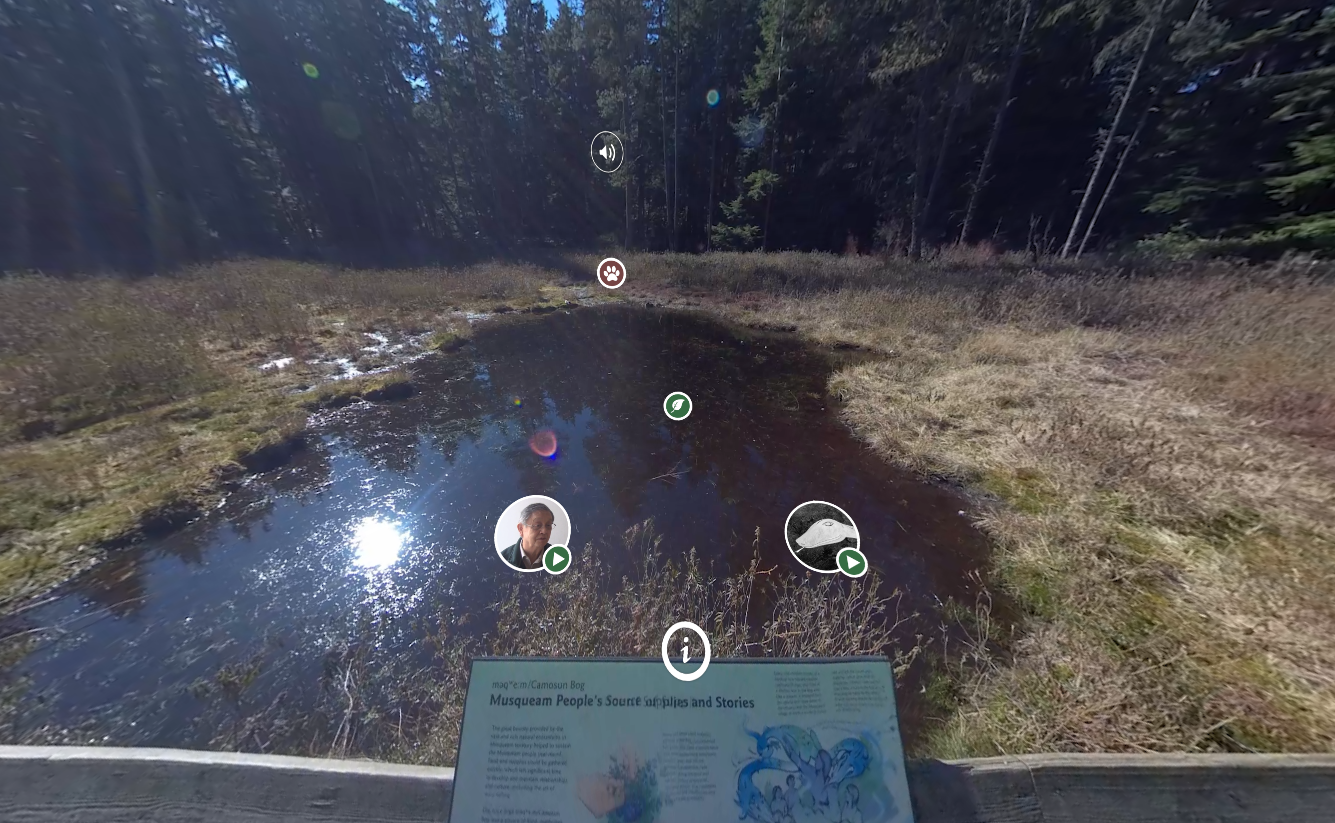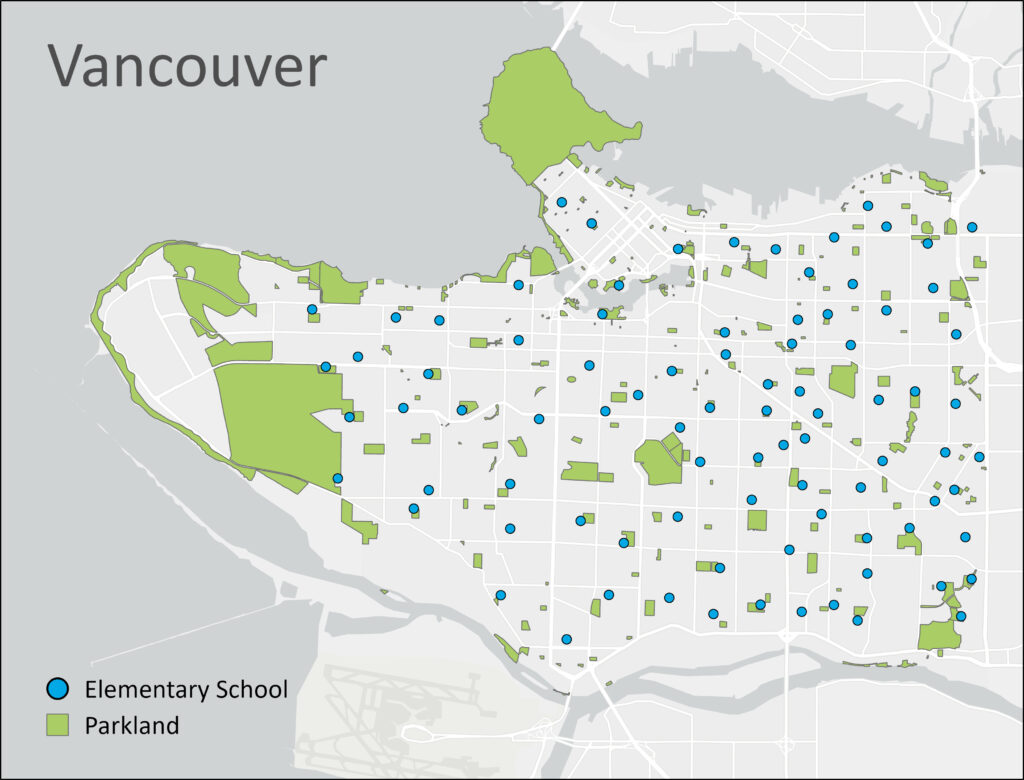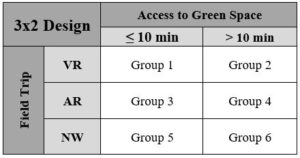Research
My PhD research is centered around a comparative analysis of virtual, augmented, and nature walk-based field trips of Camosun Bog, located in Vancouver, British Columbia, Canada. I am interested in how these technologies can promote connection to nature, pro-environmental behavior, and ecological literacy in children who differ in their access to green space.

Camosun Bog VR Field Trip, Location: Pond
Statement of Problem
Educators are increasingly turning to VR and AR to facilitate environmental education as these technologies have been shown to increase learning achievement, communication between peers and knowledgeable others, motivation to learn, problem solving skills, and pro-environmental behavior. VR and AR can allow children to virtually access locations they otherwise could not while augmenting their outdoor experiences through the reification of environmental processes. They also have the potential to provide scaffolding across formal and informal environmental education programs.
While there is a robust collection of research on the advantages of these technologies, few have investigated their comparative efficacy. Such research has only become more urgent as online and digitally mediated learning has increased since the onset of the COVID-19 pandemic. Further, research on how VR and AR promote connection to nature, and pro-environmental behavior are limited, and have yet to compare how students with varying levels of access to suitable green space are impacted by these technologies.
Research Objectives and Questions
The primary objectives of my research are:
-
- Compare the efficacy of VR, AR, and nature walk-based field trips for students with different levels of access to green space in Vancouver, British Columbia Canada.
- Provide solutions, best practices, and recommendations for educators seeking to use VR, AR, and/or nature walk-based field trips in their environmental education programs.
Three research questions guide my study and its analysis:
-
- How do VR, AR, and nature walk-based field trips compare in how they promote connection with nature, ecological literacy, and pro-environmental behavior in children?
- How does the assessment of learning objectives in question one compare across students with different levels of access to green space?
- What best practices surrounding VR and AR technologies can be gained from the answers to questions 1 and 2, and how can these support a critical approach to environmental education?
Study Area
Participants for this study are being recruited from elementary schools and elementary annexes in the Vancouver School District (VSD), British Columbia, Canada. The VSD includes 89 elementary schools and annexes, which contain approximately 28,000 students.

Accessibility Analysis
Accessibility analysis of urban green space for use in environmental education will be confined to freely accessible public land in the study area.
Quality Analysis
Quality analysis of this green space for use in environmental education will be based on landcover analysis, with locations that include high percentages of complex forest and shrubland, meadows, beaches, and waterways being preferred over those that are primarily comprised of built structures, concrete, or fields designed for sports and recreation. While formal standards for green space that are suitable for environmental education in the Vancouver School District do not exist, these will be extrapolated from those areas that the City of Vancouver and its research partners have indicated are representative of such spaces.1 Landcover ratios of representative locations will be determined using 2 meter resolution imagery and zonal statistics in ArcGIS Pro. Other parkland within the study area will then be compared to the minimum extent and ratio of preferred landcover in these representative locations, and a one-at-a-time (OAT) local sensitivity analysis will be conducted to determine the location of quality green space.
Network Analysis
The network analyst extension for ArcGIS Pro will be used to conduct a closest facility analysis of quality green space, determining the minimum distance to this amenity from each school in the study area. Street and routing data will be combined with a pedestrian walking time of 80m per minute and adjusted for hilly terrain, stops, crosswalks, and physical impediments. A 10 minute walking time will then be used to stratify treatment groups in this study; however, service area analysis of 5, 8, 10, and 20 minutes will also be conducted to provide a more nuanced account of physical accessibility to quality green space. These standards are based on the 2018 Vancouver Board of Parks and Recreation’s Park Provision Study.2
Equitability Analysis
Equitability analysis will be conducted by reaggregating Canadian census data to school catchment areas using a binary dasymetric approach. In brief, a residential land use layer will be joined with census data and rasterized to 1m x 1m cells. Zonal statistics will then be used to calculate values at the school catchment level. An analysis of variance (ANOVA) will then be paired with post-hoc tests to compare distance and quantity based measures of accessibility across different sociodemographic groups.3
Field Trip Development
VR Fieldtrips are being developed in 3DVista for Android and iOS platforms. 3DVista is a program designed to create 360o tours using interconnected photo or video spheres that include embedded content via media hot spots.4 Video and audio showcasing community restoration work, Indigenous learning content, and local flora/fauna has been captured using a 4K HDR camera, or sourced from partner organizations and publicly available websites.
VR fieldtrips will be deployed to students using Google Cardboard and student mobile devices in participating classrooms, Meanwhile AR fieldtrips will use QR codes and a mobile device to provide the same supplementary materials to students while in Camosun Bog. Nature walk-based fieldtrips will consist of a traditional, guided tour using printed materials and students will be asked to not use mobile devices for its duration.
Experimental Design
This study uses a quasi-experimental non-equivalent groups design combined with factorial analysis with treatment groups divided by field trip type and access to green space:

As assignment to each treatment group is not random, this will be accounted for through the use of a pre-testing to provide baseline measurements of connection to nature, pro-environmental behavior, and ecological literacy.
Testing and Surveys
Connection to nature will be measured using the Connectedness to Nature Scale (CNS), while pro-environmental behavior will be measured using the Major Environmental Value Model (2-MEV). The CNS measures a child’s sense of community, equality, and embeddedness to nature5, while the 2-MEV measures values, attitudes, and intention to preserve and utilize nature6. While it would be preferable to measure actual behavior, rather than self-reported behavior and intention to act, this is not logistically possible given the level of access I will have to participants. Questions testing ecological literacy will be based on curricular standards set by the B.C. Ministry of Education for the grade levels being investigated and will be covered by the learning materials developed for the field trips. Five short answer questions will be provided to students and scored before being converted to a five-point scale.
Semi-Structured Interviews and Child-Centered Interviews
Single participant, semi-structured interviews will be conducted with teachers, community members, and parents with an audio-recording being taken of each session. Interview questions will focus on exploring how effective the field trips were in promoting the learning objectives being studied. I will also ask about difficulties encountered while using the three types of field trips, and about the access issues participants may have encountered in their environmental education more generally. Special attention will be given to access issues surrounding ability, culture, race, or socioeconomic status.
Interview scripts will be adjusted for different groups of participants, particularly students. A child-centered interview strategy, using pictures to assist children in understanding interview questions will help promote more authentic explanations in this study.
Field Notes and Participant Observation
Field notes and participant observation will be conducted in classrooms and Pacific Spirit Regional Park. As I will be leading field trip activities this will provide an opportunity to reflect on my role as an educator, while connecting themes that emerge during the interview process with first-hand experience.
Data Analysis
A pre-test-post-test difference score will be calculated for each participant and a factorial ANOVA/post-hoc test will be used to compare treatment groups. Coding of interview data and field notes will also be used to provide explanation and context for these results.
- Reichstein, N. (2018). The classroom in open air: Outdoor environmental learning in Vancouver Parks. Vancouver Board of Parks and Recreation.
- Vancouver Board of Parks and Recreation. (2018). Park Provision Study, V.2 (p. 54). Vancouver Board of Parks and Recreation.
- Analysis adapted from: Almohamad, H., Knaack, A., & Habib, B. (2018). Assessing Spatial Equity and Accessibility of Public Green Spaces in Aleppo City, Syria. Forests, 9(11), 706.
-
3DVista (2021). VR. https://www.3dvista.com/en/vr.
- Mayer, F. S., & Frantz, C. M. (2004). The connectedness to nature scale: A measure of individuals’ feeling in community with nature. Journal of Environmental Psychology, 24 (4), 503-15.
- Bogner, F. X., Johnson, B., Buxner, S., & Felix, L. (2015). The 2-MEV model: Constancy of adolescent environmental values within an 8-year time frame. International Journal of Science Education, 37(12), 1938-1952.
